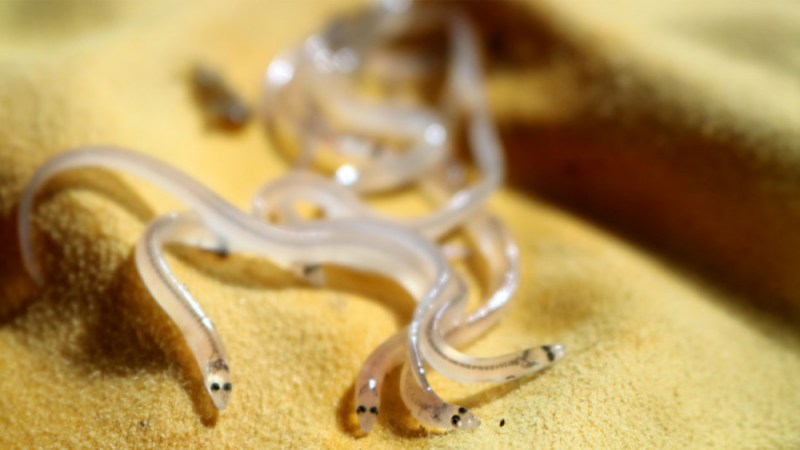How citizen scientists are protecting ‘glass eels’

The Hudson River used to be among some of the most contaminated rivers in the United States. Following decades of environmental legislation and activism, wildlife including bald eagles, bears, and whales are being spotted in New York in larger numbers. The Hudson is also an important habitat for migratory American eels, who are now getting some help from citizen scientists.
For the first time, this citizen science data will be treated as official data entered in the Atlantic States Marine Fisheries Commission’s (ASMFC) peer-reviewed eel stock assessment report. Since 2008, the Hudson River Eel Project has relied on close to 1,000 citizen scientists donating their time every spring to net, count, and release about two million juvenile American eels.
“What I love about the eel project is it takes another step deeper toward volunteers actually becoming scientists and thinking about research methods and the research questions we’re trying to answer,” Chris Bowser, project leader and Cornell University environmental scientist and educator, said in a statement.
[Related: How eels might hitch a ride to Europe.]
The project has several monitoring sites between Troy south towards New York City. Volunteers count and track the juveniles who are often called glass eels, since they are transparent at this stage of life. Their data helps inform conservation management decisions, since the species is an essential part of the food web.
An eel’s life
American eels hatch about 3,700-miles miles southeast of the Hudson in the salty Sargasso Sea. When they are larvae, the eels are shaped like willow leaves and they migrate north towards the freshwaters of the Caribbean islands, South America, the Gulf of Mexico, and the Atlantic coast from Florida to Canada.
To get to New York, the eel larvae catch a ride on the Gulf Stream current. They transform into their translucent 2-inch long glass eel state when they hit the brackish waters of coastal estuaries. They migrate into the 150-mile Hudson River tidal estuary every year from February through May. Glass eels then serve an important form of prey for larger organisms.
When they move into freshwater streams and creeks, they develop pigment and turn into miniature adults called elvers. The elvers become sexually immature yellow eels in their next adult phase, turning a brown, dark green, gray, or mustard yellow color. These older eels become apex predators that help balance the ecosystem by eating fish, aquatic insects, and crustaceans.
They may remain yellow eels for five to 30 years before they reach sexual maturity and turn into silver eels. The sexually mature silver eels then head back down to the Sargasso Sea to spawn and likely die.
Citizen scientists stepping in
Tributaries and estuaries can create a bottleneck for the swimming juveniles, which provides those studying them an opportunity to catch, count, and release the eels to get an idea of population trends that can inform larger scientific studies.
“When done right, citizen science can be very helpful because it can greatly expand an agency’s or a biologist’s geographic spread, and also a time series [spread over time] with tens of thousands of volunteer hours over the years,” said Bowser. “We have tried to collect data that is as robust as what’s been done at the agency level.”
[Related: How to become a citizen scientist—and when to leave it to the professionals.]
ASMFC accepted the most recent data in August 2023, partially due to the eel project’s strong data quality-control procedures. Partners from Cornell University and the New York State Department of Environmental Conservation developed these standards to make sure that their protocols were easy to follow, standardize, and could be repeated every year. According to Bowser, the citizen scientists are all well trained and their eel count numbers and procedures are checked.
Eels have been found in every waterway that connects with the Hudson River, including urban rivers such as the Saw Mill River in Yonkers, the Fall Kill Creek in Poughkeepsie, and the Poesten Kill creek further north in Troy. They also swim in rural areas, including the Hannacroix Creek in New Baltimore and Black Creek in Esopus.
“The widespread geographic diversity of eels means that you also have widespread diversity of volunteers,” said Bowser. “Different ages, different socioeconomic backgrounds, different experiences.”
Monitoring at the Fall Kill Creek site in Poughkeepsie for this migration season began in late February. There, local high school students and their teachers wade into about two feet of water around nets and traps that are set up along the shoreline where the glass eels swim. Another group may be counting and weighing the eels, while others gather air and water temperature data.
‘Every single dam is a potential barrier’
Chemical pollutants, overfishing, climate change, habitat loss and human-man obstructions like dams have all taken their toll on the eels over the years.
“Every single dam is a potential barrier for eels on their migration route,” Bowser said.
To help combat this, the eels that the project counts are released past at least the first known barrier to their migration, whether it be a road, culvert, or dam.
If you are interested in participating in a citizen science project like the Hudson River Eel Project, visit citizenscience.gov to find something nearby.










